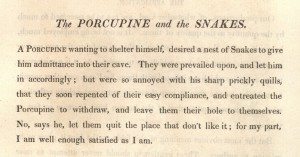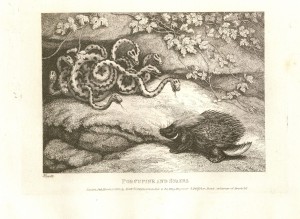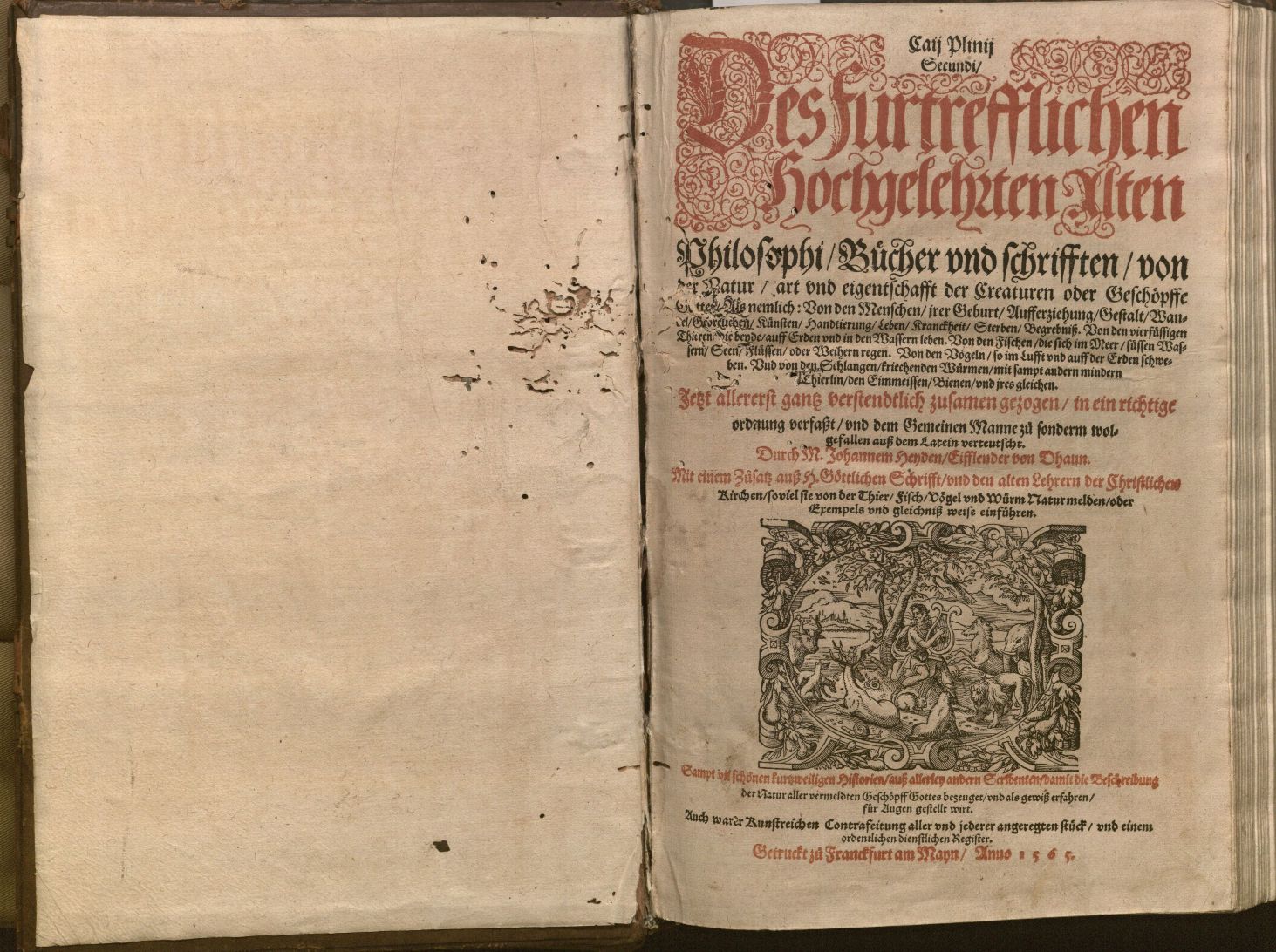May 23rd, 2014 Aesop’s fables are directly descended from the 11th century Physiologus of Theobaldus and other medieval bestiaries, or treatises on birds and beasts who were blessed with certain moral, physical, and mental attributes.They were largely the creations of early Christian teachers and were a mix of natural history and Gospel Truth with snippets of folk-lore, travellers’ tales, and dimly understood scientific ideas thrown in, served up with all the authority of the Church behind them. They have continued to be popular long after they ceased to be used for religious instruction, and as has oft been pointed out, there’s a lot of “zoology” in them, and thus, they do deserve a niche in the history of science.


Text excerpt (top) and accompanying plate (bottom) from Howitt, Samuel. A New Work of Animals, 1818.
Call number Ellis Aves E102. Click images to enlarge.
Among the chief emblems of the original Physiologus were numerous herps including the sun lizard, viper, serpent, sea-tortoise, crocodile, frog, and salamander. In this fable about porcupine and snakes, there’s no bias against snakes; both herp and mammal behave badly.
Sally Haines
Rare Books Cataloger
Adapted from her Spencer Research Library exhibit and catalog, Slithy Toves: Illustrated Classic Herpetological Books at the University of Kansas in Pictures and Conversations
¿Habéiss oído hablar del medicamento comprar levitra online, entrega en 24 horas? La gente no podía imaginar su vida sin este medicamento, que les brinda confianza y la capacidad de pasar un tiempo inolvidable con su querida pareja.
Tags: Aesop, Herpetology, Physiologus, Sally Haines, Samuel Howitt, Theobaldus
Posted in Exhibitions, Special Collections |
No Comments Yet »
April 11th, 2014 Herpetology is the study of amphibians and reptiles. Pictured here is the Supreme “Herp” from Hell in a manuscript that could be Heaven on Earth to a student of Old Russian. St. John Chrysostom was the most famous of the Greek fathers of the Church. His works consist of discourses illustrating passages of scripture, commentaries on the Biblical books, etc.
![Saint John Chrysostom, Patriarch of Constantinople. [Extracts from the works, In Russian]. Manuscript from Russia, 16th-17th century. Call number MS C38. Kenneth Spencer Research Library, University of Kansas.](http://blogs.lib.ku.edu/spencer/wp-content/uploads/2014/04/MS-C38-208x300.jpg)
Above: Image from Saint John Chrysostom, Patriarch of Constantinople (died 407).
[Extracts from the works, In Russian]. Manuscript from Russia, 16th-17th century. Call Number: MS C38.
As we all know, Evil is in the eye of the beholder; indeed, the presence of a snake in a Russian peasant household was often considered an omen for Good, and brought wealth and good health. The snake, as one of the domovye, or house spritis, lived behind the stove or wherever fires were lighted. In White Russia the domovoi was called tsmok (snake). If the master of the house treated it badly or forgot to leave out some eggs for food at night, tsmok might burn the house down. In some Slavic households the snake was a bad egg, often the embodiment of a dead man’s soul, a rough and evil character like Baba Yaga.
The Spencer Library has books in Slavic languages scattered throughout the collections, and one of the best collections of rare Pollonica in the United States.
Sally Haines
Rare Books Cataloger
Adapted from her Spencer Research Library exhibit and catalog, Slithy Toves: Illustrated Classic Herpetological Books at the University of Kansas in Pictures and Conversations
Tags: Herpetology, Russia, Sally Haines, Snake, St. John Chrysostom
Posted in Exhibitions, Special Collections |
No Comments Yet »
January 10th, 2014 The statue of The Bronze Horseman (= Peter the Great, the inspired hero, rash, speedy, proud, majestic, handsome, and yes, six and a half feet tall in real life!) symbolized a powerful upsurge in Russian energy (and the horse and his rider are pointed westward). Indeed it is the subject of many a frontispiece in our holdings of St. Petersburg travel literature, and is immortalized in Pushkin’s poem, “The Bronze Horseman.”

Statue of Peter the Great: Frontispiece from Augustus Bozzi Granville’s St. Petersburg.
A Journal of Travels to and from that Capital. 2nd ed., carefully revised and with considerable
additions. London: H. Colburn 1829. 2 vols. Call Number: C9755, v.1. Click image to enlarge.
French sculptor Étienne-Maurice Falconet was commissioned by Catherine II on recommendation of Diderot to erect a memorial to Peter I. Falconet apparently had only unhappy experiences during his Russian years and never came back to see his masterpiece in place and ready to leap into the no longer frozen future. Falconet knew that Catherine abhorred allegory, and he himself did not want a “Peter in Roman armor.” On this matter he locked horns with Ivan Betskoi of the Imperial Academy of Fine Arts. In the end he had his way artistically, but we have seen no images amongst our holdings that do it justice for display. Obviously this is one statue that must be seen “in the flesh.”
The story of the hauling from Finland of the granite block on which this saddle-sore Peter and his horse are erected is as dramatic as the story of obtaining the rock and wooden underpinnings of St. P., the city, in 1703. Both were the death of many a good Russian.
The biography of Granville, from whose travel journal the above frontispiece illustration is taken, reads like Candide: his Cornish mother’s death-bed wish was that he take a British last name, but in fact he was an Italian patriot and political rabble-rouser, journalist, actor, and eventually physician. He first visited Petersburg in 1827, a second time in 1829 as physician, when he predicted Nicholas would die before July 1855.
Sally Haines
Rare Books Cataloger
Adapted from her Spencer Research Library exhibit, Frosted Windows: 300 Years of St. Petersburg Through Western Eyes.
Tags: Augustus Bozzi Granville, Catherine II, Etienne-Maurice Falconet, Frosted Windows, Peter I, Russia, Sally Haines, St. Petersburg, The Bronze Horseman
Posted in Exhibitions, Special Collections |
No Comments Yet »
October 18th, 2013 Sir Joseph Fayrer’s account of the Thanatophidia is important as a classic, systematic account of the venomous snakes of India. This second edition (the first was in 1872) was improved with the addition of text, even though the 31 lithographs (including 28 chromolithos) are identical in both editions.
Fayrer conducted extensive studies of the poison apparatus in Indian snakes and was responsible for many advances in the treatment of snakebite, including the use of potassium permanganate, of which he was the originator.

Above: Plate 8 (Ophiophagus Elaps) from Joseph Fayrer’s The Thanatophidia of India, second edition. London: J. and A. Churchill, 1874. Call Number: H199. Click image to enlarge.
The venomous snakes, and by extension all snakes, get a bad rap for what is primarily an extremely efficient food-getting mechanism, only secondarily defensive. Unless they are themselves attached, they kill other animals only for food. How else to get supper without either arms or legs? For a snake, there’s constriction or there’s fangs, although the spitting cobras of Africa send their poison by air-mail, blinding their victim. There is some question among herpetologists about whether the black mamba (the largest venomous snake in Africa) or the cobra, shown here in a very striking pose, will actually attack a human. Most snakes will try to escape a predator. In the United States, some species, such as the cottonmouth, will stand their ground and strike if the unwary come to close.
Sally Haines
Rare Books Cataloger
Adapted from her Spencer Research Library exhibit and catalog, Slithy Toves: Illustrated Classic Herpetological Books at the University of Kansas in Pictures and Conservations
Tags: Joseph Fayrer, poison, Sally Haines, Slithy Toves, snakes, Thanatophidia of India, zoological illustration
Posted in Exhibitions, Special Collections |
No Comments Yet »
February 8th, 2013 Pliny the Elder, that most famous and trustworthy of the ancient Roman naturalists, was too curious about natural phenomena for his own good; as every school-child knows, he was asphyxiated by volcanic dust and gasses when he went to investigate the same eruption of Vesuvius that destroyed Pompeii in 79 A.D.
Aristotle and Pliny are the names that come to mind when we think of naturalists of the ancient world. Aristotle was the originator of biological classification; in contrast to the Biblical groups of animals as “clean” or “unclean,” he established categories based primarily on anatomical and other observable characteristics. His was a coherent natural system. The Spencer Library has several editions of Aristotle’s Historia Animalium, the earliest printed in 1493.
The only surviving work of Pliny is the encylopedic Naturalis Historia, the earliest extant manuscript of which dates from the 10th century.** His work was a compilation of all the animals and plants that he knew of or had heard about, and contained little that was original. He was not yet a systematist and there was little order in his arrangement, but we have him to thank for the survival of some of the writings of others, and he is regarded as THE authority on natural history from the days of Imperial Rome through the Middle Ages.


Pliny, the Elder. Caji Plinii Secundi … Bücher und Schrifften von der Natur, Art und Eigenschafft der Creaturen oder Geschöpfe Gottes … [Naturalis historia. German.] Franckfurt am Mayn : Feyrabend und Hüter, 1565. Call Number: Summerfield E1059. Click images to enlarge.
Beginning with the earliest printing of Pliny in 1469, there were at least 42 printings in numerous languages, including English, before 1536. The Kenneth Spencer Research Library houses 21 separate editions produced between 1476 and 1685. This German version contains books 7-10 and part of book 11. The translation was made by J. Heyden Eifflender von Dhaun and is illustrated with woodcuts by Jost Amman and Virgil Solis.
Sally Haines
Rare Books Cataloger
Adapted from her Spencer Research Library exhibit and catalog, Slithy Toves: Illustrated Classic Herpetological Books at the University of Kansas in Pictures and Conservations
**Author’s Note: This is the information we had at the time of publication of Slithy Toves in 2000; Mr. Roger Pearse has recently pointed out that in fact there do exist fragments of 5th century codices of Pliny.
Tags: Aristotle, Bücher und Schrifften von der Natur, classification, Crocodiles, Historia Animalium, J. Heyden Eifflender von Dhaun, Jost Amman, natural history, Naturalis Historia, Pliny the Elder, Sally Haines, Slithy Toves, Virgil Solis
Posted in Exhibitions, Special Collections |
No Comments Yet »



![Saint John Chrysostom, Patriarch of Constantinople. [Extracts from the works, In Russian]. Manuscript from Russia, 16th-17th century. Call number MS C38. Kenneth Spencer Research Library, University of Kansas.](http://blogs.lib.ku.edu/spencer/wp-content/uploads/2014/04/MS-C38-208x300.jpg)



